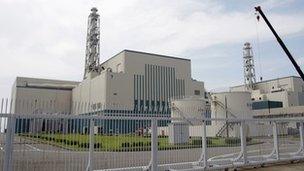Japan left with one nuclear reactor after shutdown
- Published

The Kashiwazaki-Kariwa power station is not currently in operation
Japan has shut down another nuclear power station, bringing it a step closer to suspending atomic energy, following the Fukushima disaster.
Only one of the 54 nuclear reactors remains in operation, and it is due to be switched off in May.
Residents have demanded reactors not be turned back on after routine maintenance due to safety fears.
A tsunami in March 2011 triggered the Fukushima nuclear plant meltdowns.
The No 6 unit at the Kashiwazaki-Kariwa power station in Niigata prefecture has been taken offline by the Tokyo Electric Power Co for maintenance. This leaves just the nuclear reactor on the island of Hokkaido in operation.
It is unclear when the reactors that have been turned off might be restarted.
Before the Fukushima disaster, nearly a third of Japan's electricity was generated with nuclear power.
But the six-reactor Fukushima Daiichi nuclear plant was badly damaged by the earthquake and tsunami, with explosions and partial meltdowns in several of the reactors.
The government has been carrying out stress tests on nuclear power stations to try to persuade people living nearby that they can resist strong earthquakes.
But since the Fukushima disaster, local communities have been refusing to allow reactors to be restarted after routine maintenance, which has to take place every 13 months.
In the meantime, Japan has increased its fossil fuel imports, with electricity companies pressing old power plants into service.
But there could still be a shortfall of electricity in the summer, reports the BBC's Roland Buerk.
Last year, big companies ran factories at night and at weekends after the government ordered them to cut their electricity consumption by 15%.
Manufacturers have also warned that more production may have to be moved abroad if the situation persists, which would damage Japan's economy.
- Published5 March 2012
- Published11 March 2012